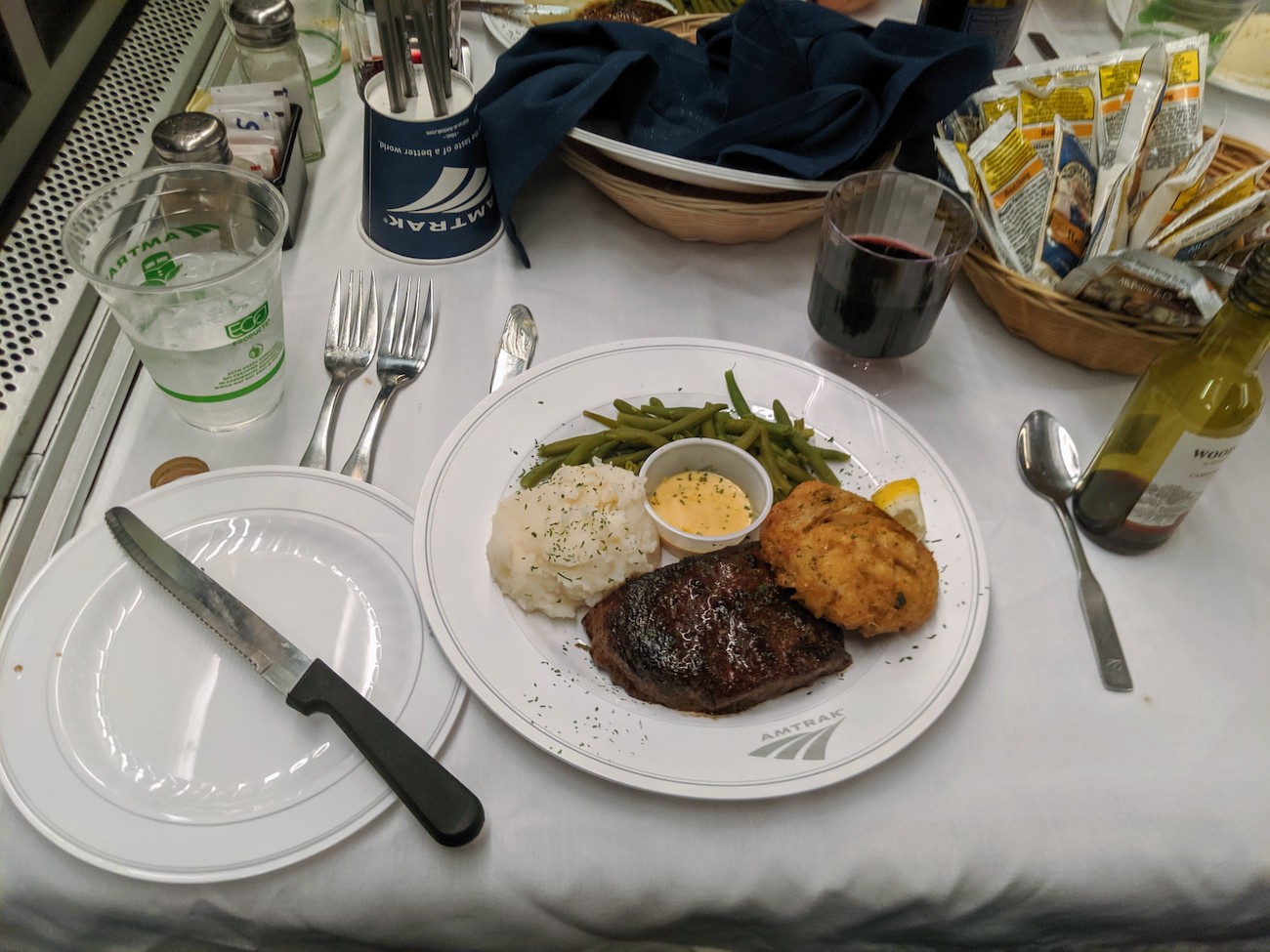- I recently set off on a four-day journey from coast to coast via Amtrak.
- The food, for the most part, was way better than I had ever expected.
- I stepped off the train a few pounds heavier – and much happier – than I thought possible.
- Visit Business Insider’s homepage for more stories.
Surf and turf was far from what I expected to eat on my first cross-country Amtrak trip.
I had previously reported on a massive backlash to some dining-car changes on shorter routes, where custom-cooked food is going by the wayside, but the promise of gourmet eats on a moving train in the middle of North Dakota seemed far-fetched to say the least.
Determined to figure out for myself what was behind the hype, I set off on Amtrak’s Empire Builder in Chicago last week. Over three days – and five meals – we crossed through wide expanses of the American heartland, through towns large and small, and past beautiful snow-capped peaks.
Read more: It took me 96 hours to ride an Amtrak train from coast to coast. I’d do it again in a heartbeat.
To be sure, the food on this part of my journey was a stark difference from my introduction to dining on rails. On the first half of the trek from coast to coast, I tried Amtrak's new "contemporary" meal service, which has rolled out on some routes east of the Mississippi River.
But after Chicago, things improved massively. Here's what we ate:
Dinner requires reservations, which immediately signals "fancy" to me.

By the time the attendant came to take my choice, I was relegated to either 5:30 (too early) or 8:30. I went with the latter, seeing as I had two days to kill on this train.
Despite the reservation, you still have to wait to be called to the dining car.

Near each thirty-minute time slot, a dining car attendant came over the intercom inviting passengers to make their way to dinner. From there, I waited at the door as instructed to be sat at one of the roughly 12 four-top tables.
Next is where things get bizarre. Each passenger has to fill out this slip, which looks not unlike a Scantron answer sheet from school.

The bubbles have items in general categories like "poultry entree" or "healthy menu option." I assume these let the company track what's being ordered, while allowing for some flexibility.
"They've said computers are coming for the entire 12 years I've worked here," the waiter said when I asked whether the forms were eventually scanned into a computer or somehow tallied.
The menu had way more choices than I expected. And with only two dinners, I wanted to make the most of it.

I eventually settled on the "land and sea combo," because, let's face it, I'm never going to pass up a steak.

Alcohol, unfortunately, is not included with dining-car meals on this train. I also forgot to take a photo of my dessert - a cheesecake with freshly whipped cream - because of the riveting conversation with my table-mates.
After waking up in Snowy North Dakota, I needed a hearty breakfast, and pancakes did the trick.

Fluffy pancakes with crispy edges and gobs of butter - with a thick slab of pork sausage on the side - were exactly what I needed to warm up and wake up.
With all the calorie burning I got from sitting around the train all day reading and listening to podcasts, a hearty lunch was in store. I went with the cheeseburger (bacon added, of course).

My lunchtime companions ordered the steamed mussels, which looked delicious. I do regret that I had but one lunch to eat on this journey.
I chose the latest reservation slot again for my second, and final, dinner. This time I went with the salmon.

It wasn't the best fish I've ever had. It was slightly dry, but still had plenty of flavor. The spicy sauce was delicious, too. It's hard to mess up a baked potato, which I also wolfed down in no time.
My dessert this time was a chocolate bundt cake, also with whipped cream, and a caramel sauce in the middle. It put me right into a sugar coma and I passed out for the night.
The next morning, I overslept and missed the pancakes before they sold out. Instead, I went with an omelette of green onions and bell peppers, with grits and a croissant on the side.

Since things were quiet, and service had finished for the trip, I popped my head into the small service area to see the dumbwaiters that carry food up from the kitchen below.

It's impressive how many individual dishes such a small kitchen can churn out while in a moving train.
Luckily, the dining car changes that are affecting the East Coast might not come in their exact iteration to these longer routes.
"West of the Mississippi, these trains are typically two nights," Roger Harris, Amtrak chief marketing and commercial officer told me.
"They're typically a 48-hour train to the West Coast, so the onboard service is a more important part of the journey, and people have more dining events while they're traveling. It's more complicated than on the East Coast, where people generally get on in the evening, have a meal, and then get off in the evening."
That's sure to be welcome news for the travelers who look forward to these meals.
Now read:

- Nearly one-third of all Amtrak trains are late - and it could be costing the railroad $42 million every year
- It took me 96 hours to ride an Amtrak train from coast to coast. I'd do it again in a heartbeat.
- I tried Amtrak's new 'contemporary' dining car and it was immediately clear why so many people want to save the old one
- The full history of Amtrak's iconic dining cars, which the company says it is removing to cater to millennial whims

